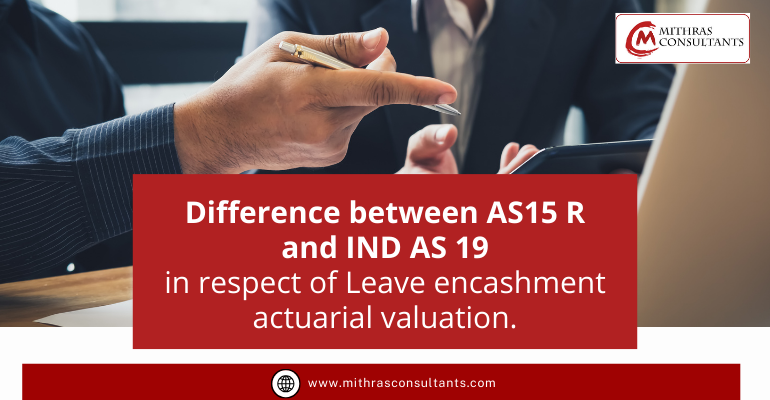Difference Between AS 15 R and IND AS 19 in Leave Encashment Actuarial Valuation

Actuarial valuation of leave encashment is essential for businesses to accurately assess and record employee leave liabilities. In India, AS 15 (Revised) and IND AS 19 are two primary standards guiding this valuation. AS 15 R applies to most Indian companies, while IND AS 19 is mandatory for listed entities and large corporations. Although both standards aim to account for employee benefits, they vary in their approach, scope, and calculations for leave encashment provisions.
Understanding these differences is crucial for businesses in adopting the correct methodology. Let’s explore these standards in detail, highlighting their unique requirements and the implications for leave encashment actuarial valuation.
1. Overview of AS 15 R and IND AS 19
AS 15 R and IND AS 19 are accounting standards developed for recognizing employee benefits in financial statements. Both standards aim to accurately record liabilities associated with employee benefits, including leave encashment. Here’s an overview:
- AS 15 R: Applicable to companies following Indian GAAP, this standard covers various employee benefits, including leave encashment, gratuity, and pensions. It emphasizes a straightforward approach suitable for smaller organizations.
- IND AS 19: Based on the International Financial Reporting Standards (IFRS), IND AS 19 applies to companies following the Indian Accounting Standards. It’s more comprehensive, including stricter requirements for actuarial assumptions and disclosures.
Understanding these standards helps businesses align their reporting with regulatory requirements, ensuring clarity and consistency in financial statements.
2. Scope and Applicability
Both standards cater to different types of organizations, influencing their applicability:
- AS 15 R: Primarily intended for Indian companies adhering to Indian GAAP, including private firms and small to medium enterprises.
- IND AS 19: Mandatory for large public companies, specifically those listed on the stock exchanges and required to follow IFRS-aligned Indian Accounting Standards.
Key Differences in Scope:
- AS 15 R offers flexibility, making it simpler for smaller entities.
- IND AS 19 mandates stricter guidelines and wider disclosures, aligning with global standards.
In practical terms, smaller firms can benefit from the simplicity of AS 15 R, while larger, globally-focused entities need to adopt IND AS 19 for accurate reporting.
3. Valuation Approach and Actuarial Assumptions
A critical difference between AS 15 R and IND AS 19 lies in their valuation approach and the actuarial assumptions needed for calculating leave encashment provisions.
- AS 15 R: Encourages companies to adopt a projected unit credit (PUC) method but provides some flexibility. It requires basic actuarial assumptions, such as discount rates and attrition rates.
- IND AS 19: Strictly mandates the use of the PUC method and requires detailed actuarial assumptions, including expected salary increments, mortality rates, and employee demographics.
Key Actuarial Assumptions in IND AS 19:
- Discount rate based on government bonds
- Expected salary growth rate due to inflation
- Employee turnover rate to anticipate attrition
4. Disclosure Requirements and Reporting
Both AS 15 R and IND AS 19 require companies to disclose the impact of leave encashment liabilities, yet IND AS 19 imposes more detailed reporting requirements.
AS 15 R Requirements:
- A simpler disclosure approach.
- Companies disclose the leave encashment liabilities without extensive breakdowns.
IND AS 19 Requirements:
- Detailed disclosures on the actuarial assumptions.
- Sensitivity analysis showing how changes in actuarial assumptions impact liabilities.
- A reconciliation of leave encashment liability movements.
For companies, this means IND AS 19 offers transparency but requires significant time and effort to meet these requirements.
5. Actuarial Valuation and Expense Recognition
Expense recognition for leave encashment varies significantly under AS 15 R and IND AS 19, impacting how companies account for these liabilities in their income statements.
- AS 15 R: Allows flexibility in recognizing expenses, often focusing on simpler calculations, which helps small and mid-sized companies manage their liabilities efficiently.
- IND AS 19: Mandates recognizing expenses systematically. This includes dividing costs into current service cost, past service cost, interest cost, and actuarial gains or losses.
Expense Components in IND AS 19:
- Current Service Cost: Cost of employee benefits accrued during the current period.
- Interest Cost: Interest on the accrued liability due to the passage of time.
- Actuarial Gains/Losses: Changes in liabilities from updated assumptions, recognized in other comprehensive income (OCI).
Businesses adopting IND AS 19 need robust actuarial evaluations and should prepare for increased expense transparency.
6. Impact on Financial Statements and Decision-Making
The choice between AS 15 R and IND AS 19 affects a company’s financial statements and decision-making processes.
- AS 15 R: Results in a simpler financial impact. It’s more suited to entities prioritizing ease over international comparability.
- IND AS 19: Provides a comprehensive financial view, aligning with global standards, which can assist multinational companies in benchmarking their employee benefits.
Adopting IND AS 19 helps businesses improve transparency, aiding in investor confidence. Smaller companies benefit from AS 15 R’s flexibility, which requires fewer disclosures and simpler calculations.
Conclusion
Choosing between AS 15 R and IND AS 19 is critical for businesses that aim to manage their leave encashment liabilities effectively. Mithras Consultants offers expert actuarial services to help businesses navigate these standards. Our customized solutions enable clients to make informed decisions in their financial, insurance, and risk management matters, ensuring compliance and accuracy in financial reporting.

 Call Us
Call Us Whatsapp Us
Whatsapp Us